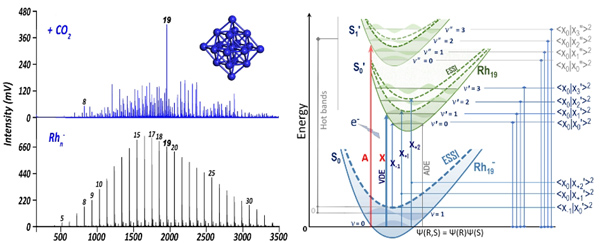Location: Home > Research News
Research News
Researchers Find a New Magnetic Superatom Cluster
Metal-atomic clusters which have specific structures and well-defined components bridge the gap between atoms and macroscopic matter. The realization of magic number clusters with superatomic stability and unique property is an attractive project enabling to develop new materials by precise atomic construction. 
Recently, In a study published in Sci. Adv., Prof. Zhixun Luo’s group from the Institute of Chemistry Chinese Academy of Sciences (ICCAS) and Prof. Jun Li’s group from Tsinghua University found a super-octahedron Rh19? cluster in sufficient gas-collision reactions showing an expanded understanding of the magnetic superatoms and the anion photoelectron spectroscopy (PES) involving electron-spin state isomers (ESSIs).
They first studied the formation and reactions of anionic Rhn- (n=3-33) clusters with a few typical gases (including O2, CO2, CH4, and CH3Br) via an integrated instrument of time-of-flight mass spectrometry (TOF-MS) combined with PES apparatus. They found a magic-number cluster Rh19- which shows up with prominent mass abundance, indicative of its distinct inertness.
The structure of Rh19- was determined by using a first-principles global-minimum (GM) search combined with high-precise DFT calculations. Interestingly, the ground-state structure of Rh19- corresponds to an Oh-symmetric octahedron with 10 spin-unpaired electrons (namely, a spin magnetic moment of 10.95 μB).
Then,they investigated the electronic structure to fully understand the distinctive stability of the high-spin Oh-Rh19-. It was found that the frontier orbitals exhibit superatomic features. These delocalized superatomic orbitals are beneficial to the balanced electron-nuclei interactions thus enhanced stability.
The PES of Rh19- exhibits electronic hot bands before the first major electronic transition state (labeled as X). Theoretical calculations revealed that the ground state of Rh19- has a high spin of S=10/2 but allows for the existence of low-lying electron-spin state isomers (ESSIs).
This magnetic superatomic cluster Rh19- presents a perfect example of the co-existence of multiple electron-spin state isomers while keeping the same spatial structure, suggesting potential applications in atomically precise manufacturing involving quantum computing and spintronics.

Mass spectra of rhodium cluster anions reacting with CO2, PES mechanism involving ESSIs and the Hirshfeld charge population of Rh19? (Image by Chaonan Cui)
Contact:
Prof. Zhixun Luo
Email: zxluo@iccas.ac.cn





